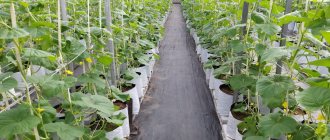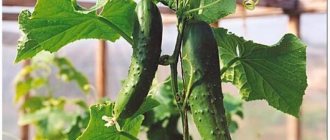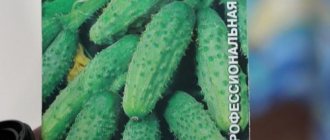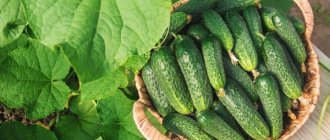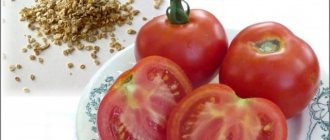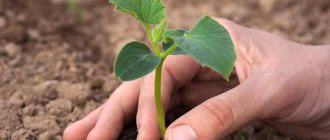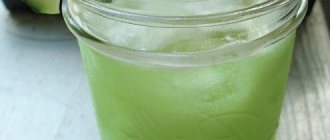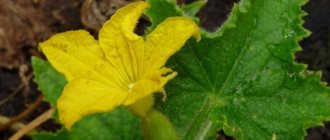Early parthenocarpic cucumber “Berendey f1” is a first-generation hybrid bred by Russian breeders. In 2007, it was included in the State Register of Breeding Achievements approved for use. According to the register, it can be grown indoors in the Northern, Northwestern, Central, Volga-Vyatka, Central Black Earth, North Caucasus and Middle Volga regions of Russia. Its main purpose is canning. You can see the fruits of “Berendey” in the photograph.
Characteristics of the variety
“Berendey f1” is an early variety, the fruits are ready for harvest 44–46 days after seed germination. The variety is parthenocarpic, does not require pollination, and therefore is suitable for growing in open ground, under film cover, and in greenhouses. The shade tolerance of the variety also allows it to be grown in an apartment on a balcony and windowsill. The plants are indeterminate, moderately branching, with female flowers. The leaves are green, medium in size. There are an average of 3 fruits in the nodes. Other characteristics:
- the greens are cylindrical, covered with pimples with light spikes;
- the color of the fruit is bright green, with white stripes;
- the pulp is crispy, not bitter;
- fruit length 12–14 cm, weight 120–140 g;
- yield 12–14 kg/1 m2;
- Up to 8 kg of cucumbers are harvested from one plant;
- Cucumbers are good for pickling and pickling, salads.
The Berendey f1 variety is characterized by resistance to such common diseases as powdery mildew, root rot, and downy mildew.
On a note! “Parthenocarpic” means “reproducing without pollination.” This is the difference between self-pollinating and parthenocarpic plants: the flowers of self-pollinating plants have both stamens and pistils, and the plant pollinates itself, while parthenocarpic plants do not have pollination. "Indeterminate" means "with unlimited growth."
Growing cucumbers on the balcony
Berendey cucumbers can be grown on a windowsill, balcony, or loggia. Cultivation on the south side requires light shading from direct sunlight.
Cucumbers do not like drafts, so the room should be protected from the wind. A possible solution is a glass balcony. For good fruiting, maintaining a microclimate is required.
When there are sharp temperature fluctuations, additional heating is needed, and when there is a lack of light, an artificial light source is needed. To grow cucumbers, use simple containers for balcony flowers.
They save space and can be conveniently positioned taking into account the size chart. Containers should have drainage holes necessary to remove excess moisture, and a stand to collect it.
A layer of expanded clay drainage is placed at the bottom, and soil is poured on top, which can be purchased in specialized stores. When planting seeds, you can additionally add complex mineral fertilizers to the soil composition.
Advantages and disadvantages of the variety
One of the main advantages of “Berendeya” is its shade resistance: unlike many other cucumber varieties, it does not need bright sunlight; the plant feels best in partial shade. This property allows you to grow cucumbers of this variety in a city apartment.
Its other advantages:
- fruits set without pollination;
- high speed of fruit growth and ripening;
- large harvests;
- good presentation;
- resistance to negative factors;
- cucumbers do not become bitter and do not overgrow;
- the fruits are well stored and transported.
The only disadvantage we can name is that “Berendey f1”, like other early ripening varieties, cannot be treated with potent chemicals, as this will lead to a concentration of toxins in the fruits. Also, you cannot collect seeds from this variety: firstly, it is a first-generation hybrid, which means its beneficial properties are not inherited, and secondly, it is a parthenocarpic variety, that is, it either does not have seeds or they are underdeveloped. Therefore, material for sowing will have to be purchased annually.
First shoots
Already on the third day, “stirring” in the soil became noticeable, and the rings of seedlings were visible. The next day the first few real shoots appeared. That is, on October 10, the first shoots appeared.
Along with the cucumbers, I sowed the seeds of other vegetables on the same day, and they sprouted no earlier than a week later. It turns out that Berendey’s seed germination is fine.
Out of 10 seeds, 7 full sprouts have sprouted and one is still trying to break through. In the picture you can see the poor guy, only one leaf came up from him...
But even if it’s 7 out of 10, that’s 70%. Very good result!
10 days after sowing
This is what the sprouts looked like on October 17th.
Some of the sprouts have already developed third leaves...
They are also called cotyledons or the first true leaves. After these leaves have fully opened, the cucumbers can be planted.
To be continued…
Planting seeds in the ground
Berendey seeds can be sown directly into the ground. In this case, it is recommended to pre-harden them, this will help increase productivity. The seeds are wrapped in cloth and placed in water, and when they swell, they are placed in a refrigerator for two days at a temperature of +3°C and above. The fabric should be damp all the time.
The seeds are sown no earlier than mid-May according to the 50x50 pattern, deepening them by 1.5–2 cm. If sown in open ground, the crops are covered with film, which is removed after germination. If necessary, the plants are thinned out, leaving the healthiest and most developed ones.
Harvesting and storage
Harvesting takes place one and a half months after the sprouts appear. As a result of the high fruiting of the Berendey variety, the fruits are picked immediately after they appear. Thus, the next fruit appears literally in 1 day.
It is recommended to store cucumbers in a cool place. If the fruits are intended for immediate consumption, they are stored in the refrigerator. If cucumbers are left for longer storage, vegetable growers advise storing them in the cellar.
Seedling
Seeds for seedlings are planted in the third ten days of April. A universal primer with a pH of 6.3–6.8 is suitable for the procedure. Sprouted seeds are planted in plastic cups with a perforated bottom or in peat cups. For each seed you need one cup. The seeds are buried 1.5–2 cm. The cups with sprouts are left in the room at a temperature of +24°C. It is recommended to keep the seedlings on the windowsill for at least 4 weeks.
Watering is carried out daily with settled water at room temperature. Fertilizers are applied 2-3 times a month. The simplest fertilizer to prepare is a urea solution (1 tbsp per 3 liters of water). Fertilizers should not be overused.
10 days before planting in the ground, it is advisable to harden the seedlings by reducing their temperature to 16°C (for example, by placing them on a glazed balcony). Seedlings are planted when the soil temperature becomes high enough - +17°C. This happens at the end of May - beginning of June. By this time, the seedlings should already produce more than 3 leaves. Planting pattern 50x50.
Characteristics and preparation of seed material
To get a high yield, it is important to choose high-quality seeds and take into account the characteristics of sowing. The seed material should be one-dimensional, have good germination, and germination intensity.
Before planting in the ground, you need to carefully study the description on the packaging and check for pre-treatment of the seeds. Agricultural companies involved in the sale of material mainly carry out processing with highly effective means.
Care
Berendey cucumbers are quite unpretentious. However, they need to be provided with proper care - weeding, watering and fertilizing. The amount of water for irrigation depends on the weather and the stage of plant development. Until the ovaries appear, 5 liters of water are required in dry weather and 3 after rain per 1m2 of beds. Formed fruits require increasing watering to 10 and 6 liters, respectively. The soil around cucumbers should always be moist.
On a note!
Water the cucumbers with warm water in the morning or evening, but under no circumstances during the midday heat.
For fertilizer, a mineral complex with nitrogen, sulfate and magnesium is usually used. Additionally, you can apply organic fertilizers, for example, mullein diluted with water. It is possible to enrich water for irrigation: 10 g of urea per 10 liters of water.
You may be interested in:
5 proven fertilizers for a rich harvest of cucumbers To obtain a bountiful harvest of cucumbers, it is not enough just to sow the seeds correctly or plant seedlings. To…Read more…
After watering, cucumbers must be hilled, because “Berendey f1” does not like hardened soil. Loosening should be done carefully so as not to damage the roots located near the surface. Loosening the soil and weeding is done once every 10 days.
When growing in open ground, there is no need to form Berendey vines; you can cut off 3-4 lower shoots without touching the central stem and upper side shoots. The vines of greenhouse cucumbers are tied to trellises.
Agrotechnical methods and care after planting
Caring for plants in a greenhouse is traditional. It is recommended to water cucumbers in the evening, at the root, with warm, settled water (+21ºC), approximately 9 liters per 1 sq.m. A good humidity level in a shelter is considered to be 80%. The frequency of the procedure is affected by the temperature in the greenhouse and outside, as well as the level of illumination. More often, moisten the soil once every 2-3 days. In extreme heat every day.
Attention!
Mulching will help simplify maintenance. Weeds, sawdust or hay will do. Layer 8 cm. Mulch will inhibit the growth of weeds and protect the soil from drying out and forming a hard crust.
Aerate the soil weekly. The bushes are tied up and trellises are used. Pinch the lateral shoots above the second or third leaves to increase yield. Bushes and growing fruits are inspected for diseases.
After planting the seedlings, fertilizing is carried out for 15-17 days, and then every 10 days. Before flowering, the “Diamofoska” fertilizer is suitable; it contains: nitrogen, phosphorus and potassium. During the flowering period, potassium nitrate and superphosphate are added. When the first fruits ripen - a solution of ash, urea. Traditional herbal infusions and solutions made from yeast, boric acid, onion peel, etc. have proven themselves well.
Growing in an apartment
For cultivation on a balcony or windowsill, only parthenocarpic and self-pollinating varieties that are shade-tolerant are suitable. “Berendey f1” meets these requirements. To set up a home garden you will need:
- Container for flowers 25 cm wide and 80 cm long with holes and a stand for water drainage.
- Universal soil for vegetables with peat and vermiculite (a mineral from the hydromica group).
- Drainage, for example, fine expanded clay.
- A liter bottle of liquid fertilizer for indoor flowers.
- Clothesline with holder and thinner twine.
A drainage layer of 2–3 cm is laid on the bottom of the container. Then soil is poured, not reaching 4–5 cm from the edge of the container, watered generously and, when the soil settles, filled to the same mark. Holes for seeds should be made in the center of the container at intervals of 30 cm. Seeds, previously hardened, are buried 1.2–2 cm, two per hole. The crops are covered with film and placed on a warm, illuminated windowsill at a temperature of +24 – +26°C.
The surface of the soil is sprayed with water from a spray bottle to keep it moist. After 4–6 days, shoots will appear, and the film will need to be removed. If there are two sprouts in the hole, the weakest one will have to be cut off. After this, the temperature in the room should be reduced to +20–+24°C, and the soil temperature should be kept at +18–+20°C. After 10-20 days, when the sprouts produce 2-3 true leaves, the plants can begin to be hardened under an open window during the day when there is no wind. At the same time, they are fed weekly with a solution of complex fertilizer.
Important!
You can transfer cucumbers to the balcony when the average temperature is +15°C, when frost will probably not happen.
When plants have more than 5 leaves, trellises for climbing plants are used as support. At this stage, they need to be fed weekly with a fertilizer solution (from 250 ml per plant). When there are 6-8 leaves, you need to start tying them up. At a height of 2.5 m above the cucumbers, a clothesline is pulled, twine is tied to it with one end, and the other to the stem of the plant 2–2.2 cm above the ground. The stem is wrapped around twine.
After tying, loosen once every 7 days. It is imperative to form a stem by removing the lateral shoots and tendrils. When the shoot reaches the clothesline, the top of its head is pinched - leaving one leaf, tearing off the rest.
Cucumber BERENDEY cultivation
This variety can be planted directly in the beds, or it can be pre-grown in greenhouse conditions.
In most parts of the country, seeds should be planted immediately in a permanent place at the end of the first ten days of May. The seeds are characterized by high germination (almost 100%), rapid emergence.
Cucumbers Berendey video
The distance between neighboring plants should be about 0.5 m, the row spacing should be 0.5 m.
After sowing, the beds are covered with plastic film to protect the seedlings from possible spring frosts. After the likelihood of night cold passes, the film can be removed. If the seedlings are too close to each other, they should be thinned out, leaving the strongest plants.
Seed material for seedlings in a greenhouse is planted in the last ten days of April. You need to grow seedlings in a greenhouse in the same way as at home.
These cucumbers do not grow well in the shade, and the ripening fruits may have an irregular shape. Therefore, the place where the beds with this hybrid will be located should be well illuminated by sunlight, and the soil should be prepared in such a way that it is loose and fertile.
• The best cucumbers for growing in a greenhouse
Care for this variety of Berendey cucumbers is standard:
- compliance with the irrigation regime. Use warm, filtered water, water it so that the top layer of soil is constantly moist;
- once every 5-7 days, loosen the soil around the cucumber bushes;
- growing cucumber vines do not form in beds, but in greenhouses they are tied to trellises.
To increase yield, side shoots developing at the level of 2-3 permanent leaves must be removed.
Useful tips
On average, water every 3 days. It is also necessary to maintain air humidity, for which a basin of water is placed on the balcony. In the evenings, cucumbers are sprayed with water. By early autumn, when the nights become cool, the containers can be wrapped in a thin blanket to warm the cucumber roots.
It must be remembered that even in urban conditions, plantings are threatened by harmful insects such as aphids, whiteflies, and spider mites. Therefore, you should regularly inspect the plants for damage and spray them with special preparations. You can also use folk remedies:
- tobacco decoction helps against aphids and whiteflies (tobacco from 10 cheap cigarettes should be boiled in 10 liters of water for 10 minutes);
- against ticks - garlic infusion 0.5 kg of garlic needs to be chopped, poured with warm water, left for 5 days, strained and used.
To make the infusion stick to the leaves, add 60 ml of infusion and 50 g of grated laundry soap to 10 liters of water.
Diseases and parasites
The varieties of cucumbers that were developed by the Gavrish breeders are distinguished by strong immunity. Berendey cucumbers are not susceptible to fungal diseases and are also not susceptible to pests.
The seeds of this variety are characterized as cucumbers that are resistant to the most popular diseases of cucumbers: root rot, white and gray rot, as well as powdery mildew.
In addition, if you properly care for the plant, it is not attacked by pests such as aphids, spider mites or whiteflies.
However, it is important to understand that the bushes of the plant must be carefully inspected every day. This procedure is carried out in order to prevent the proliferation of pests on the plant, or the progression of the disease, if such a risk suddenly appears.
If the appearance of harmful insects is observed, the plant must be sprayed with chemicals “Aktara”, “Bitoxibacillin” or “Iskra-M”.
Reviews
Elena
I recommend for breeding on the balcony and windowsill. The seeds are coated with a nutrient mixture; no need to soak. I collected a large number of cucumbers, the main thing is to plant them in a large pot so that the soil does not dry out. The downside was that it often had to be watered.
Anastasia
This is not the first year I have been planting these cucumbers on the balcony in St. Petersburg. Germination is excellent and they grow quickly. There is not much sun in St. Petersburg, so shade tolerance is checked! I planted it in April and took it out to the balcony in mid-May. I tried to plant it twice during the season, the second time at the end of summer, but in vain, there were no more cucumbers.
The hybrid parthenocarpic variety “Berendey f1” is distinguished by its high yield - up to 14 kg/m2, pleasant taste, and is well stored and transported. The fruits can be canned or eaten raw. Unlike most cucumbers, "Berendey" is shade-tolerant, it does not require bright lighting, and this makes it suitable for growing in city apartments.
Diseases and pests
Early ripening varieties must not be treated with strong chemicals: this leads to a concentration of toxins in the fruit. In the fight against diseases, solutions of organic and mineral origin are most often used:
- Powdery mildew is prevented using a solution of milk with the addition of soap and iodine. The foliage of the bushes is treated with this mixture.
- Gray and white rot will not touch the roots of plants that have been watered with water and baking soda.
- Bacteriosis is vulnerable to Trichopolum. 2 tablets are diluted per 1 liter of water.
Cucumber Berendey F1. Gavrish
Cucumber Berendey F1. Gavrish
Vegetable garden on the windowsill - Cucumbers in 50 days on the northern balcony
Harmful insects can cause more damage to crops than disease. The greatest danger to the variety are slugs and spider mites. You can get rid of these pests by preparing the soil in the fall. The soil must be dug up and left to freeze. You can also plant garlic and onions between the beds.
Agricultural cultivation technology
Cucumbers can be grown using the seedling method. Seeds for seedlings are sown in the third ten days of April. Seeds can be planted dry, but pre-treatment with an aqueous solution will ensure the appearance of friendly shoots.
For planting, you need to prepare a soil mixture, which includes:
- garden soil - 2 parts;
- peat - 1 part;
- washed river sand - 1 part.
The soil is disinfected by heat treatment or special means. When unfolding the cotyledons, the seedlings are transferred to a cool place with an air temperature of +18 °C.
Caring for seedlings consists of fertilizing with complex fertilizers and regular watering. At the beginning of May, at the stage of formation of 3-4 true leaves, the seedlings are transferred to a permanent place.
10 days before planting, the plants are hardened by lowering the temperature to + 16°C. The optimal condition for planting seedlings is to warm the soil to +17…+18°C.
To avoid damaging the root system when planting, you can use containers with a removable bottom or peat pots. In a permanent place for growth, plants are placed at a distance of 50 cm from each other.
Direct sowing of seeds into the ground is carried out in mid-May. This growing method significantly reduces the time required to obtain seedlings.
Regardless of the planting method, when cultivating the variety, the rules of crop care must be followed. Water the plants at sunset to prevent burns on the leaves. To do this, use warm water.
The crop loves moisture, so you need to ensure that the surface layer of soil does not dry out. The frequency of watering in a greenhouse depends on the air temperature inside and outside the room, and the level of light.
Video: TOP 7 SUPERBUNK CUCUMBERS YOU WILL BE AMAZED BY THEIR PRODUCTIVITY
Video: THE BEST variety of Cucumber for growing at home on a window. No. 1
In closed ground, when growing cucumbers on an industrial scale, you can organize a drip irrigation system.
To increase yield, it is recommended to stop the growth of side shoots at the level of 3 leaves. In order to prevent plants from being damaged by biological pests and diseases, it is necessary to constantly inspect the leaves.
Advantages and disadvantages of a hybrid
A description of a cucumber variety cannot be complete without listing its strengths and weaknesses. Hybrid Berendey f1 is characterized exclusively on the positive side:
- tastes amazing;
- high-yielding;
- attractive in appearance;
- universal in purpose;
- grown both in open ground and under film;
- pollinates on its own.
The commercial arsenal of fruits is about 15 kilos of cucumbers per square meter of area.
The characteristics of the Berendey variety do not say anything that it has any disadvantages. Well, except that it is one of the hybrid ones. But this can hardly be seriously considered as a big drawback for the cucumber...
Description of cucumbers Berendey f1
Hybrids of the first generation of Berendey cucumbers - an innovative release of scientific breeding. All products of this agricultural holding are famous for their high parameters: consumer standards, ease of cultivation, productivity, survivability.
Description of cucumbers Berendey f1
Brief information about the variety
- Fruits: tasty fruits weighing up to 140 g on thin vines of medium height.
- Productivity: harvested about 14.5 kg per m².
- Resistance: the breeder guarantees immunity to diseases and pests.
- Where it is grown: the variety is recommended for the central regions of Russia, the Volga region and the Caucasus.
- Planting dates: last ten days of spring - early summer.
- Planting technology: direct sowing in the ground and seedling technique.
- Soil: light, humus-rich soil is recommended for cultivation.
- Consumer status: versatility. The variety is suitable for consumption raw and excellent for preservation.
Varietal features
Cucumber Berendey f1 was included in the state register in 2007 and recommended for open, unprotected cultivation, growing in greenhouse complexes and (as an option) on the window sills of balconies or loggias.
The variety is early ripening: it takes approximately 45-50 days from hatching to fruiting. In addition, the cucumber hybrid is self-pollinating, with a predominance of the female type of flowering.
External description
Ripe cucumbers grow up to 14 cm in length and quickly gain good weight (up to 140 g). The fruits delight the eye with their cylindrical format and pimples with whitish pinches.
The plant is herbaceous, annual. The vines are moderately branched, of medium height, with medium-sized leaves and abundantly developed ovaries.
Productivity and marketable conditions
According to the description, the Berendey cucumber is a modern high-yielding variety. In favorable climatic conditions (subject to all norms and rules of agriculture), even beginning gardeners achieve good harvests: about 14.5 kg/m².
Application area
One of the basic characteristics of this variety is versatility. Cucumbers are suitable for consumption raw, are widely used as ingredients in various dishes, and are excellent for any kind of preservation (barrel salting and marinade fillings).
Resistance to diseases and pests
Cucumber hybrids of the Gavrish brand are famous for their immunity to fungal and bacterial diseases and harmful bio-forms.
Berendey seeds are presented by the manufacturer as cucumbers resistant to root rot, powdery mildew, white and gray rot. With proper agricultural technology, they are not susceptible to attacks by aphids, spider mites and whiteflies.
Regional recommendations
The fruits have an excellent taste
The cucumber variety Berendey f1 is recommended by the expert community and the manufacturer for cultivation in the central regions of Russia, the Volga region and the Caucasus. In the Far Eastern, Northern and Northwestern regions it is impossible to do without film greenhouses and tunnels.
The hybrid is positioned as shade-tolerant: cucumbers of this type can also be grown at home, on window sills and balconies.
Advantages and disadvantages
More than 10 years of active cultivation in industrial agricultural complexes and private home greenhouses have revealed a series of positive aspects and only one annoying drawback of the variety. The undoubted advantages in the description are:
- agrotechnical flexibility: it can be grown both in open ground and in a greenhouse;
- high taste qualities of fruits;
- excellent presentation;
- fertility;
- transportability and keeping quality;
- wide range of applications.
Adherents of organic farming and supporters of “pure varieties” condemn this variety for its hybrid origin. The only drawback of selection is the inability to select seeds yourself.
Sowing seeds
Direct sowing is carried out in early summer. Bypassing the seedling phase, the gardener minimizes the investment of time and effort and smoothes out agrotechnical corners.
The seeds are characterized by one-dimensionality and rapid germination: before planting, the seeds are disinfected, activated with stimulants and microelements (soaked in a special solution twelve hours before sowing).
The planting pattern is standard: a 50/50 pitch with a depth of 1.5-2 cm. To avoid night frosts, the crops should be protected with a special covering material. When there is an abundance of seedlings, thinning is carried out.
Growing seedlings
If it is necessary to guarantee a high yield, seedlings are planted in the last ten days of spring.
- Dry seeds are treated with growth stimulants;
- The seed scattering is placed in soil mixed with peat and sand (2:1:1);
- Everything is spilled with warm water and covered with film;
- After the appearance and unfolding of the cotyledons, the juveniles are protected from overheating.
